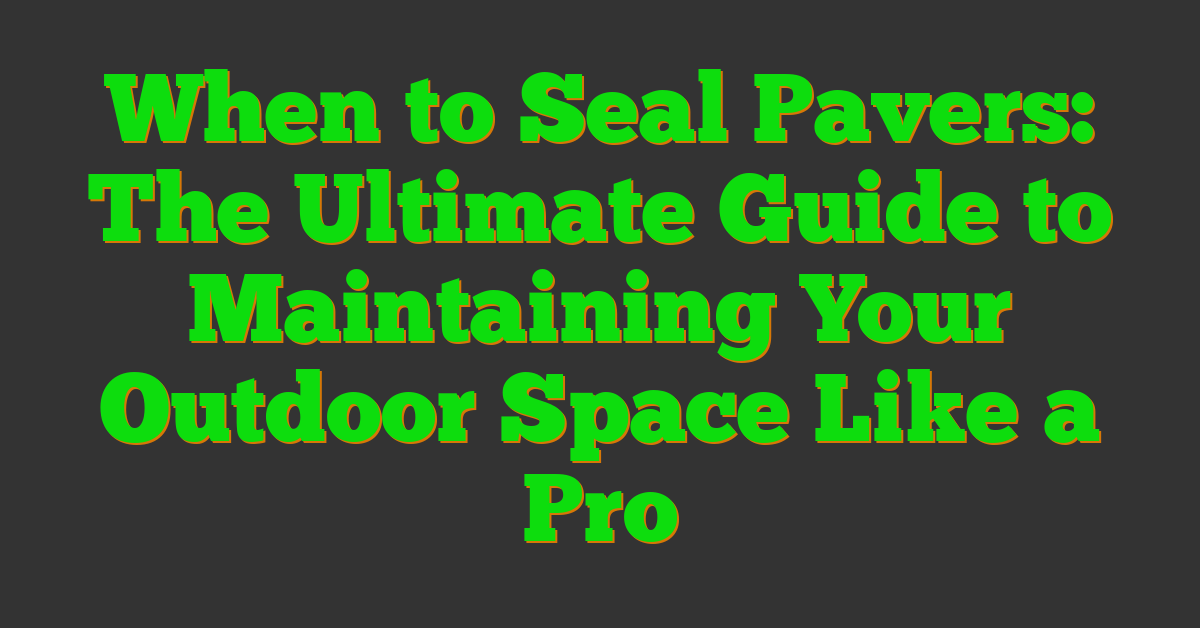Sealing pavers can be a crucial step in maintaining the beauty and durability of your outdoor space. It’s a process that can enhance the colors, protect against stains, and prolong the life of your pavers. But when is the best time to seal them? Understanding the right timing for sealing your pavers can make a significant difference in the outcome.

We’ll explore the factors that influence the decision to seal pavers, including the type of pavers, weather conditions, and the overall condition of the surface. By knowing when to seal your pavers, you can ensure that the investment you’ve made in your outdoor area stays looking its best for years to come. Let’s dive into the key considerations for determining when to seal your pavers and how to make the most of this maintenance task.
Understanding Paver Sealing
As landscape designers, we know the critical role that sealing pavers plays in preserving the allure and robustness of outdoor spaces. It is essential to grasp the nuances of paver sealing to make informed decisions for maintaining the beauty and longevity of your outdoor areas.
Benefits of Sealing Pavers
Sealing pavers offers a myriad of advantages that contribute to the overall appeal and durability of your outdoor hardscapes. By applying a quality sealant, you not only enhance the vibrancy of the colors but also create a protective barrier against unsightly stains. Moreover, sealing helps in extending the lifespan of your pavers by shielding them from the harsh effects of weather and foot traffic.
Different Types of Paver Sealants
When it comes to choosing the right sealant for your pavers, it’s important to consider the various options available in the market. From solvent-based sealers that provide a glossy finish to water-based sealants offering a more natural look, there are diverse choices to suit your aesthetic preferences and maintenance requirements. Understanding the characteristics of different sealants can help you select the most suitable one for your outdoor space.
Assessing the Right Time to Seal Pavers
As landscape designers, we understand the importance of timing when it comes to sealing pavers. Proper timing ensures that the sealant can effectively protect the pavers and enhance their appearance for an extended period. Let’s delve into key considerations to help you determine the right time to seal your pavers.
Evaluating Weather Conditions
When assessing the optimal time for sealing pavers, we need to pay close attention to the weather conditions. It’s ideal to seal pavers when the weather is dry and moderate. Avoid sealing during rainy or extremely hot days, as these conditions can affect the sealer’s application and drying process.
Considering Paver Age and Condition
Another crucial factor to consider is the age and condition of the pavers. Newly installed pavers should typically cure for a specific period before sealing to ensure proper adhesion of the sealant. Additionally, if the pavers show signs of wear, such as fading colors or the presence of stains, it might be the right time to seal them to revitalize their appearance and protect them from further damage.
Timing with Cleaning and Maintenance
Sealing pavers should coincide with regular cleaning and maintenance routines. Before applying the sealant, ensure that the pavers are clean and free of debris, mold, or stains. Cleaning the pavers thoroughly and allowing them to dry completely before sealing ensures optimal adhesion and longevity of the sealant. Incorporating sealing into your maintenance schedule can help you preserve the beauty and integrity of your outdoor space.
By evaluating weather conditions, considering paver age and condition, and timing sealing with cleaning and maintenance efforts, you can make informed decisions on when to seal your pavers effectively. Remember, proper timing plays a vital role in maximizing the benefits of sealing pavers for long-term durability and aesthetics.
Pre-Sealing Preparation
As landscape designers, we understand the importance of proper pre-sealing preparation to ensure the best outcome for your outdoor space. Here, we focus on essential steps to take before sealing your pavers, setting the stage for a successful sealing process.
Cleaning and Repairs
Before sealing your pavers, it’s crucial to start with a clean surface. We recommend thoroughly cleaning the pavers to remove any dirt, debris, or stains that may affect the sealing process. Pressure washing is an effective method to clean the pavers and prepare them for sealing. Additionally, inspect the pavers for any damages or necessary repairs. Addressing any cracks or uneven surfaces before sealing will help maintain the integrity of the paved area and ensure a smooth finish post-sealing.
Choosing the Right Sealant for Your Pavers
Selecting the appropriate sealant is key to achieving the desired results for your pavers. Different types of sealants are available, including water-based and solvent-based options. Consider factors such as the type of pavers, the desired finish, and the level of maintenance you’re willing to commit to when choosing a sealant. Water-based sealants are eco-friendly and offer UV protection, while solvent-based sealants provide a glossy finish and enhanced durability. We can help you assess your specific needs and recommend the best sealant for your pavers to enhance their longevity and appearance.
The Sealing Process
Step-by-Step Guide to Sealing Pavers
As landscape designers, we understand the importance of following a meticulous process when sealing pavers to achieve the desired results. First, before starting the sealing process, we ensure that the pavers are thoroughly cleaned and any necessary repairs are made. This step is crucial as it helps to remove dirt, debris, and any damages that could affect the final outcome.
Next, we carefully select the right sealant based on the type of pavers being used and the desired finish. Choosing between water-based and solvent-based sealants is a critical decision that can impact both the appearance and longevity of the paved area. Factors such as eco-friendliness, UV protection, and durability play a significant role in this selection process.
Once the pavers are clean, repaired, and the sealant is chosen, we proceed with the application. Applying the sealant evenly and thoroughly is essential to ensure complete coverage and protection. We recommend following the manufacturer’s instructions regarding the application process to achieve the best outcome.
After the sealant is applied, we allow sufficient time for it to dry and cure properly. This curing period is vital for the sealant to adhere effectively to the pavers and provide the intended protection. It’s important to avoid foot traffic or any other disturbances during this curing phase to ensure the sealant’s effectiveness.
Common Mistakes to Avoid
In our experience, we have encountered some common mistakes that individuals should avoid when sealing pavers. One of the most prevalent errors is not adequately preparing the pavers before sealing. Failing to clean the pavers thoroughly or ignoring necessary repairs can lead to subpar results and reduce the effectiveness of the sealant.
Another common mistake is applying too much sealant in one coat. Over-application can cause the sealant to become thick and uneven, compromising its protective qualities. It’s essential to follow the recommended application guidelines and apply multiple thin coats if necessary for optimal coverage.
« Unlock the Secret to Perfect Outdoor Spaces: Permeable Pavers vs. Non-Permeable Pavers Revealed Unlock the Secrets: Laying Pavers Over Dirt Made Easy! Expert Tips Inside »
Additionally, rushing the sealing process without allowing sufficient drying and curing time can diminish the sealant’s performance. Properly following the manufacturer’s guidelines regarding drying times is crucial for the sealant to bond correctly with the pavers and provide long-lasting protection.
By avoiding these common mistakes and following our step-by-step guide to sealing pavers, individuals can maintain the integrity of their outdoor spaces and enjoy the benefits of a beautifully sealed paved area.
Post-Sealing Care
How We Maintain Sealed Pavers
After sealing the pavers, proper maintenance is key to preserving the look and longevity of your outdoor space. Here’s how we recommend maintaining sealed pavers:
- Regular Cleaning: We suggest cleaning sealed pavers periodically to remove dirt, debris, and stains. Use a mild detergent or specially formulated paver cleaner to maintain their appearance.
- Avoid Harsh Cleaners: When cleaning sealed pavers, avoid harsh chemicals like bleach or acid-based cleaners as they can damage the sealant and the pavers themselves.
- Sweeping and Rinsing: Regularly sweeping and rinsing the sealed pavers can prevent the buildup of dirt and grime, keeping them looking fresh and vibrant.
- Weed Control: Keeping weeds at bay is essential for maintaining the integrity of the paved area. Regularly inspect the pavers for any weed growth and remove them promptly.
- Inspect for Damage: Periodically inspect the sealed pavers for any signs of damage or wear. Addressing any issues early can prevent further deterioration and prolong the life of your paved space.
When to Reapply Sealant
Sealants protect pavers from harsh weather conditions, UV rays, and stains, extending their lifespan. Here’s when we recommend reapplying sealant to maintain the durability and appearance of your paved area:
- Regular Inspections: Monitor the sealed pavers regularly for signs of wear, such as fading color or reduced water resistance. If you notice these signs, it may be time to reapply the sealant.
- Frequency: In general, we suggest reapplying sealant every 2-3 years to ensure continuous protection and enhance the aesthetics of the paved surface.
- High-Traffic Areas: Areas that experience heavy foot traffic or vehicular use may require more frequent reapplication of sealant to withstand wear and tear.
- Seasonal Factors: Consider resealing pavers before the start of harsh weather seasons to provide added protection during challenging conditions.
By following these maintenance tips and resealing guidelines, you can keep your outdoor space looking stunning and resilient for years to come.
Conclusion
Sealing pavers is key to elevating the look and longevity of your outdoor space. From prep work to post-sealing care, each step plays a crucial role in ensuring your paved area remains pristine for years to come. By following the outlined guidelines on sealant selection, maintenance, and reapplication timing, we can all enjoy a beautifully sealed outdoor space that withstands the test of time. Remember, a well-sealed paved area not only enhances the aesthetics but also adds durability, making it a worthwhile investment for any outdoor setting. So, seize the opportunity to seal your pavers at the right time and reap the benefits of a stunning and long-lasting outdoor space.
















